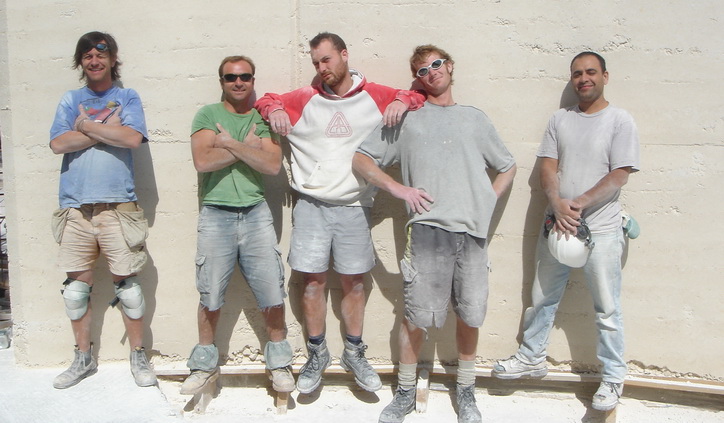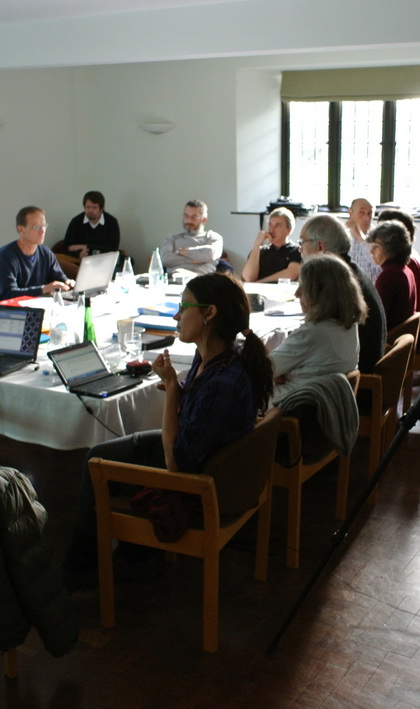| |
|
|
|
|
|
|
|
|
|
|
|
|

|
Rammed Earth Consulting CIC |
|
|
building is
more than buildings, it's people |
|
|
|
|
| |
|
| |
|
|

|
|
|
|
|
|
|
|
Rammed Earth Consulting CIC are a not for profit
consultancy dealing with a wide range of projects concerned with the
built environment. With many years experience there are plenty examples
of rammed earth buildings which we have both built and consulted on.
We offer services in soil selection on or off site.
This may involve mixing more than one other material to site soil,
more sand to a clayey soil, more stones where the soil is very fine.
And once a soil is looking ok we take it to commercial labs for
testing.
We offer design help, often at the start of a design
process, helping architects, engineers and surveyors to better
understand how rammed earth fits into a job, how strong it is, the
shapes it can be formed into and of course the cost.
We train contractors on site and liaise with
specialists where a main contractor can't manage the work. We work
with contractors on site, and we are working on training standards
which can be applied on site or at a training centre.
But building is not just buildings, its about people,
their knowledge, hopes, ideas. Building is the something which happens
in a context, hot or cold, money or loans, team or self build,
experience or not and many other factors.
|
|
 |
|
|
|
| |
|
|
| |
Rammed earth needs people with
skills, and recognised standards |
|
|
|
|
|
|
|
|
The past century has been the development of building
standards and regulations. These have appeared around the world and
while some materials have received a lot of attention, others have
been 'forgotten'. It is this deficit which is a major area of work for
us.
Rammed Earth Consulting have written a
Code of Practice
for Rammed Earth Structures which is now a national standard in 15
countries in Africa. A UK publication,
Rammed Earth: Design and
Construction Guidelines has become the de-facto standard for the use
of rammed earth in the UK, and has also influenced similar work in
France. The Guideline has also lead to BREEAM acceptance of
rammed
earth, and inclusion in the BRE IMPACT system.
Rammed earth is an integral part of the IMPACT system, to know
more about IMPACT read this article.
Rammed earth also has a National Building Specification, 25-00-70,
but you need to be on their system to use it. Being part of the NBS
system, like BREEAM, means that rammed earth has a wider audience
which leads to better understanding.
Building buildings allows
direct experience of what an earth building could look and feel like,
it is a chance to experience something very old in a new way. This is
true for the people that inhabit the building, that use it, as well as
for the designers and builders. We have concentrated on public
buildings because they allow the widest group of people to experience
this without having to use their own resources. Over time as they come
to appreciate the qualities of the material their confidence will grow
and perhaps invest in their own earth building.
So it is necessary to work with buildings
and with the wider context of building to make the use of rammed earth
easier and 'normal'. Because this takes time we have to use a wide
range of means and so we were a founder of
Earth Building UKI, a
charity which seeks to bring together the widest group of earth
building builders, users, designers, producers, funders, regulators
and students to understand better what each of us is doing. We also
try to reach as wide an audience as we can outside the earth building
world.
EBUKI has allowed us to reach across to
partners in Europe, following on from the ECVET earth plasters project
Learn With
Clay where you can download the training materials and standard
|
|
 |
|
|
|
|
|
|
|
|
|
|
|
Writing standards takes time, but changes
the context of building |
|
|
|
|
|
|
|
|
|
free. We are now writing Training Standards for Earth
Structures under the PIRATE project, which stands for
Provide Instructions and Resources for Assessment and Training in
Earthbuilding. Training can be given on site or
in a technical college, it can be self taught or from 'father to
daughter' but for that knowledge to be assessed to allow trainees to
get work there needs to be a common understanding of what needs to be
known, the skills needed and the level of responsibility someone can
be given. This is another major part of the context which building
has, the people that do it. |
|
|
|
|
|
|
|
Take a look at this film from the 1940's,
we can learn from the past |
|
|
|
 |
|
|
|
 |
|
|
|